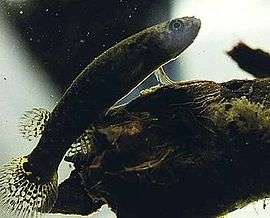Mangrove rivulus
| Mangrove rivulus | |
|---|---|
 | |
| Scientific classification | |
| Kingdom: | Animalia |
| Phylum: | Chordata |
| Class: | Actinopterygii |
| Order: | Cyprinodontiformes |
| Family: | Aplocheilidae |
| Genus: | Kryptolebias |
| Species: | K. marmoratus |
| Binomial name | |
| Kryptolebias marmoratus Poey, 1880 | |
The mangrove killifish or mangrove rivulus, Kryptolebias marmoratus (formerly Rivulus marmoratus),[1] is a species of fish in the Aplocheilidae family. It lives along the east coast of North, Central and South America, from Florida to Brazil. It is about 75 mm long.
The mangrove rivulus is a U.S. National Marine Fisheries Service Species of Concern. Species of Concern are those species about which the U.S. Government’s National Oceanic and Atmospheric Administration, National Marine Fisheries Service, has some concerns regarding status and threats, but for which insufficient information is available to indicate a need to list the species under the U.S. Endangered Species Act (ESA).
Ecology
Scientists have recently discovered that the mangrove rivulus can spend up to 66 consecutive days out of water, which it typically spends inside fallen logs, breathing air through its skin.[2] It enters burrows created by insects inside trees where it relaxes its territorial, aggressive behavior. During this time, it alters its gills so it can retain water and nutrients, while nitrogen waste is excreted through the skin. The change is reversed once it re-enters the water.[3][4]
When jumping on land, the mangrove rivulus does a "tail flip", flipping its head over its body towards the tail end. The rivulus' jumping technique gives it an ability to direct its jumps on land and to make relatively forceful jumps. A team of scientists associated with the Society for Experimental Biology released a video in 2013 showing the jumping technique.[5]
The species consists mostly of hermaphrodites which are known to reproduce by self-fertilization, but males do exist,[6] and strong genetic evidence indicates occasional outcrossing.[7] They are also the only simultaneous hermaphroditic vertebrates, and the concentration of males to hermaphrodites can vary depending on the local requirement for genetic diversity (for example, if an increase in the local parasite population occurred, secondary male numbers might increase).[8]
K. marmoratus produces eggs and sperm by meiosis and routinely reproduces by self-fertilization. Each individual hermaphrodite normally fertilizes itself when an egg and sperm that it has produced by an internal organ unite inside the fish’s body.[9] In nature, this mode of reproduction can yield highly homozygous lines composed of individuals so genetically uniform as to be, in effect, identical to one another.[10][11] The capacity for selfing in these fishes has apparently persisted for at least several hundred thousand years.[12] Meioses that lead to self-fertilization can reduce genetic fitness by causing inbreeding depression. However, self-fertilization does provide the benefit of “fertilization assurance” (reproductive assurance) at each generation.[10] Meiosis can also provide the adaptive benefit of efficient recombinational repair of DNA damages during formation of germ cells at each generation.[13] This benefit may have prevented the evolutionary replacement of meiosis and selfing by a simpler type of clonal reproduction such as ameiotic or apomictic parthenogenesis.
Conservation
This species is extremely vulnerable to habitat modification and fragmentation, environmental alteration, and human development/encroachment.
Conservation designation
- IUCN: Least Concern
- U.S. National Marine Fisheries Service: Species of Concern
- American Fisheries Society: Vulnerable
- Species of Greatest Conservation Need: Florida
Status reviews
Taylor (1999) is the last status review for the species.
See also
References
- ↑ Ong, K. J.; Stevens, E. D.; Wright, P. A. (2007). "Gill morphology of the mangrove killifish (Kryptolebias marmoratus) is plastic and changes in response to terrestrial air exposure". Journal of Experimental Biology. 210 (7): 1109. doi:10.1242/jeb.002238.
- ↑ "Tropical fish can live for months out of water", Reuters, Wed Nov 14, 2007 9:05pm GMT
- ↑ "The fish that can survive for months in a tree", Daily Mail, 17 October 2007
- ↑ "Tropical fish can live for months out of water", Reuters, Nov 14, 2007 9:05pm GMT
- ↑ "Tail-Flipping Fish Hops on Land - Video".
- ↑ Lublnski, B. A.; Davis, W. P.; Taylor, D. S.; Turner, B. J. (1995). "Outcrossing in a Natural Population of a Self-Fertilizing Hermaphroditic Fish" (PDF). The Journal of Heredity. 86 (6): 469–473.
- ↑ MacKiewicz, M.; Tatarenkov, A.; Turner, B. J.; Avise, J. C. (2006). "A mixed-mating strategy in a hermaphroditic vertebrate". Proceedings of the Royal Society B: Biological Sciences. 273 (1600): 2449. doi:10.1098/rspb.2006.3594.
- ↑ Cole, Kathleen S.; Noakes, David L. G. (1 January 1997). "Gonadal Development and Sexual Allocation in Mangrove Killifish, Rivulus marmoratus (Pisces: Atherinomorpha)". Copeia. 1997 (3): 596–600. doi:10.2307/1447566. JSTOR 1447566.
- ↑ Sakakura, Y., Soyano, K., Noakes, D.L.G. & Hagiwara, A. (2006). Gonadal morphology in the self-fertilizing mangrove killifish, Kryptolebias marmoratus. Ichthyological Research, Vol. 53, pp. 427-430
- 1 2 Avise JC, Tatarenkov A (November 2012). "Allard's argument versus Baker's contention for the adaptive significance of selfing in a hermaphroditic fish". Proc. Natl. Acad. Sci. U.S.A. 109 (46): 18862–7. doi:10.1073/pnas.1217202109. PMC 3503157
 . PMID 23112206.
. PMID 23112206. - ↑ Earley RL, Hanninen AF, Fuller A, Garcia MJ, Lee EA (December 2012). "Phenotypic plasticity and integration in the mangrove rivulus (Kryptolebias marmoratus): a prospectus". Integr. Comp. Biol. 52 (6): 814–27. doi:10.1093/icb/ics118. PMC 3501102
 . PMID 22990587.
. PMID 22990587. - ↑ Tatarenkov A, Lima SM, Taylor DS, Avise JC (August 2009). "Long-term retention of self-fertilization in a fish clade". Proc. Natl. Acad. Sci. U.S.A. 106 (34): 14456–9. doi:10.1073/pnas.0907852106. PMC 2732792
 . PMID 19706532.
. PMID 19706532. - ↑ Harris Bernstein, Carol Bernstein and Richard E. Michod (2011). Meiosis as an Evolutionary Adaptation for DNA Repair. Chapter 19 in DNA Repair. Inna Kruman editor. InTech Open Publisher. doi:10.5772/25117
External links
| Wikimedia Commons has media related to Kryptolebias marmoratus. |
- IUCN Red List: Rivulus marmoratus.
- Froese, Rainer and Pauly, Daniel, eds. (2006). "Kryptolebias marmoratus" in FishBase. April 2006 version.
- NMFS: Species of Concern Fact sheet
- Grupo Rivulus
